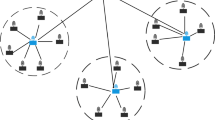Abstract
Wireless sensor networks (WSNs) have become hugely popular as security surveillance is used by the public and industries in a variety of real-time applications. The development of wireless sensor networks that strengthen the life cycle of their network through energy saving is an important issue. Due to the low resource development of the sensor terminals, they must be used intelligently and efficiently. Although the previous methods have provided better data collection and power optimization, there are some issues with the routing optimization that could not be improved. To overcome this problem, an Associative Zone Based Energy Balancing Routing (AZEBR) with Adaptive Maximization Dijkstra’s shortest path algorithm is proposed for optimized routing over the network. This proposed AZEBR method evaluates the node distance and energy of each node by selecting the performance of balance nodes. Equal amount of transmission and energy are to be maintained in every transmission. There are two special nodes for each zone selected from the center of the zone with radius (r) and a higher residual energy it is called as Associated Wise Zone (AWZ) and centered zone head (CZH). Adaptive Maximization Dijkstra’s shortest path is to solve the problem from the source to the target. New technology performance is evaluated using a network emulator (NS2). Compared to the average pocket transfer rate and index, the proposed method’s simulation results prove that AZEBR provides less delay and higher performance compared to network lifetime.





Similar content being viewed by others
References
Wang, C., Li, J., Yang, Y., & Ye, F. (2018). Combining solar energy harvesting with wireless charging for hybrid wireless sensor networks. IEEE Transactions on Mobile Computing, 17(3), 560–576. https://doi.org/10.1109/TMC.2017.2732979
Kim, D., & An, S. (2016). PKC-based DoS attacks-resistant scheme in wireless sensor networks. IEEE Sensors Journal, 16(8), 2217–2218. https://doi.org/10.1109/JSEN.2016.2519539
Shahzad, F., Sheltami, T. R., & Shakshuki, E. M. (2016). Multi-objective optimization for a reliable localization scheme in wireless sensor networks. Journal of Communications and Networks, 18(5), 796–805. https://doi.org/10.1109/JCN.2016.000108
Ma, C., Liang, W., Zheng, M., & Sharif, H. (2016). A connectivity-aware approximation algorithm for relay node placement in wireless sensor networks. IEEE Sensors Journal, 16(2), 515–528. https://doi.org/10.1109/JSEN.2015.2456931
Yang, X., Wang, L., Su, J., & Gong, Y. (2018). Hybrid MAC protocol design for mobile wireless sensors networks. IEEE Sensors Letters, 2(2), 1–4. https://doi.org/10.1109/LSENS.2018.2828339
Tolani, M., Singh, R. K., Shubham, K., & Kumar, R. (2017). Two-layer optimized railway monitoring system using Wi-Fi and ZigBee interfaced wireless sensor network. IEEE Sensors Journal, 17(7), 2241–2248. https://doi.org/10.1109/JSEN.2017.2658730
Dargie, W. (2019). A quantitative measure of reliability for wireless sensor networks. IEEE Sensors Letters, 3(8), 1–4. https://doi.org/10.1109/LSENS.2019.2931888
M. Yu, X. Yang (2018) COO-MAC: a novel cooperative MAC protocol for wireless sensor networks. IEEE Sensors Letters. doi: https://doi.org/10.1109/LSENS.2018.2883765.
Dargie, W., & Wen, J. (2020). A simple clustering strategy for wireless sensor networks. IEEE Sensors Letters, 4(6), 1–4. https://doi.org/10.1109/LSENS.2020.2991221
Xu, M., Yang, Q., & Kwak, K. S. (2016). Distributed topology control with lifetime extension based on non-cooperative game for wireless sensor networks. IEEE Sensors Journal, 16(9), 3332–3342. https://doi.org/10.1109/JSEN.2016.2527056
Wang, H., Zeng, H., & Wang, P. (2016). Linear estimation of clock frequency offset for time synchronization based on overhearing in wireless sensor networks. IEEE Communications Letters, 20(2), 288–291. https://doi.org/10.1109/LCOMM.2015.2510645
Lee, H., & Ke, K. (2018). Monitoring of large-area IoT sensors using a LoRa wireless mesh network system: Design and evaluation. IEEE Transactions on Instrumentation and Measurement, 67(9), 2177–2187. https://doi.org/10.1109/TIM.2018.2814082
Nardelli, P. H. J., Ramezanipour, I., Alves, H., de Lima, C. H. M., & Latva-Aho, M. (2016). Average error probability in wireless sensor networks with imperfect sensing and communication for different decision rules. IEEE Sensors Journal, 16(10), 3948–3957. https://doi.org/10.1109/JSEN.2016.2536148
Song, M., & Zheng, M. (2018). Energy efficiency optimization for wireless powered sensor networks with nonorthogonal multiple access. IEEE Sensors Letters, 2(1), 1–4. https://doi.org/10.1109/LSENS.2018.2792454
Jurado-Lasso, F. F., Clarke, K., Cadavid, A. N., & Nirmalathas, A. (2021). Energy-aware routing for software-defined multihop wireless sensor networks. IEEE Sensors Journal, 21(8), 10174–10182. https://doi.org/10.1109/JSEN.2021.3059789
Singh, R., Rai, B. K., & Bose, S. K. (2017). A low delay cross-layer mac protocol for k-covered event driven wireless sensor networks. IEEE Sensors Letters, 1(6), 1–4. https://doi.org/10.1109/LSENS.2017.2776303
M. Cheffena, M. Mohamed (2017) Empirical path loss models for wireless sensor network deployment in snowy environments. IEEE Antennas and Wireless Propagation Letters. doi: https://doi.org/10.1109/LAWP.2017.2751079.
Guijarro, L., Pla, V., Vidal, J. R., & Naldi, M. (2016). Maximum-profit two-sided pricing in service platforms based on wireless sensor networks. IEEE Wireless Communications Letters, 5(1), 8–11. https://doi.org/10.1109/LWC.2015.2487259
Aslam, N., Xia, K., & Hadi, M. U. (2019). Optimal wireless charging inclusive of intellectual routing based on SARSA learning in renewable wireless sensor networks. IEEE Sensors Journal, 19(18), 8340–8351. https://doi.org/10.1109/JSEN.2019.2918865
Peng, Y., Al-Hazemi, F., Kim, H., & Youn, C. (2016). Joint selection for cooperative spectrum sensing in wireless sensor networks. IEEE Sensors Journal, 16(22), 7837–7838. https://doi.org/10.1109/JSEN.2016.2608846
Chen, J., Yu, C. W., & Ouyang, W. (2020). Efficient wireless charging pad deployment in wireless rechargeable sensor networks. IEEE Access, 8, 39056–39077. https://doi.org/10.1109/ACCESS.2020.2975635
Chen, H., Li, X., & Zhao, F. (2016). A reinforcement learning-based sleep scheduling algorithm for desired area coverage in solar-powered wireless sensor networks. IEEE Sensors Journal, 16(8), 2763–2774. https://doi.org/10.1109/JSEN.2016.2517084
Azarhava, H., & MuseviNiya, J. (2020). Energy efficient resource allocation in wireless energy harvesting sensor networks. IEEE Wireless Communications Letters, 9(7), 1000–1003. https://doi.org/10.1109/LWC.2020.2978049
Author information
Authors and Affiliations
Corresponding author
Additional information
Publisher's Note
Springer Nature remains neutral with regard to jurisdictional claims in published maps and institutional affiliations.
Rights and permissions
About this article
Cite this article
Kumar, D.S., Sundaram, S.S. Associative Zone Based Energy Balancing Routing for Expanding Energy Efficient and Routing Optimization Over the Sensor Network. Wireless Pers Commun 124, 2045–2057 (2022). https://doi.org/10.1007/s11277-021-09443-7
Accepted:
Published:
Issue Date:
DOI: https://doi.org/10.1007/s11277-021-09443-7




